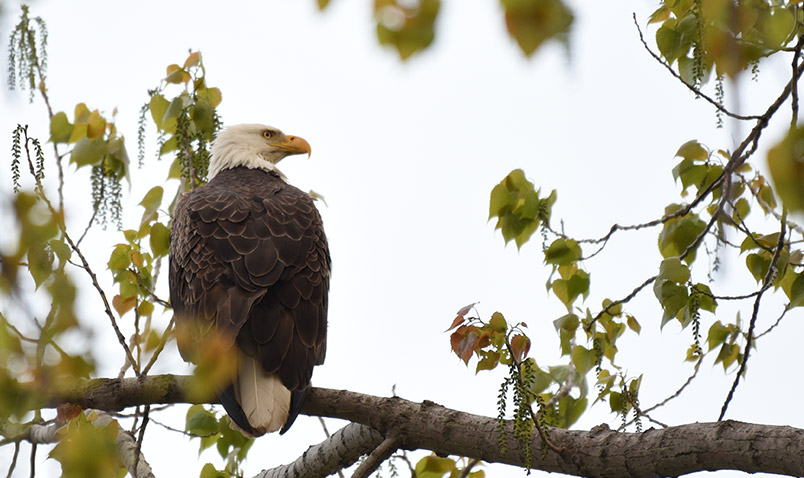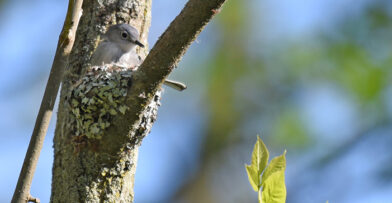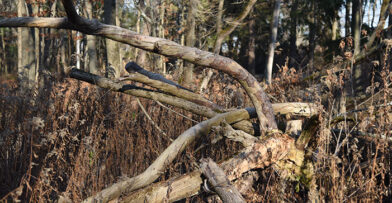Wisconsin is home to 29 species of migratory or year-round resident raptors: hawks, owls, eagles, and falcons. Depending on the season, 15 of these birds can be found in the wild at Schlitz Audubon. These strong and cunning predators keep prey populations at a healthy level and are vital beacons of Wisconsin conservation.
Raptors as Indicators
Raptors are also indicator species – animals whose presence, absence, or abundance is an indication of the health of an ecosystem as a whole. As indicator species, raptors offer insight regarding what occurs in, or is potentially harming, the environment. Over the past few decades, ecologists have seen an increase in owl mortality. Toxicology reports uncovered the majority of deaths were due to poisoning, specifically rat poison (rodenticides). Unfortunately, using these anticoagulants can take up to five days to kill a rat, and they become easy prey in the process. Owls will ingest the poisoned rodent, which results in the death of the bird, an example of biomagnification. Researchers also found that bobcats, foxes, other raptors, and humans are affected by these poisons.
A Barred Owl in Wisconsin.
Many things can be done to help the owl population. Most importantly – don’t use poisons. A family of owls can consume thousands of mice in one year. They are nature’s pest control – and they make entertaining neighbors as well! Installing a nest box invites owls to move into your yard and dine on the local rodent population.
Lead is Poisoning Raptors
But another culprit also threatens raptors, in particular birds that commonly scavenge for their food, such as Turkey Vultures, Bald Eagles, and the largest bird in North America, the California Condor. Whether from paint, fishing tackle, or lead ammunition, every lead product possesses a unique chemical signature. From this data, researchers are then able to determine which lead product has poisoned an animal. Most commonly, lead from ammunition or fishing tackle is poisoning these birds. According to the University of Minnesota Raptor Center, 90% of injured Bald Eagles they intake also have elevated lead levels in their blood. A study published in 2014 studied 3,000 eagles killed in the last 30 years found that 25% of them died from poisoning, most often by lead.
When hunters use shotguns to hunt small game and certain game birds, they shoot small metal balls made of lead, called shot. Some shot will strike the animal, but many of these projectiles end up strewn about forests and waterways. A wounded animal is an easy target for predators like raptors, which then ingest the shot as well. Similarly, lead fishing tackle can be cut from a line or ingested by fish, which are then eaten by raptors hunting in our waterways.

Bald Eagle, photographed in Wisconsin.
Fortunately, lead alternatives exist for those who wish to protect the health our national symbol while hunting and fishing. Several munitions companies produce projectiles made from a variety of metals and alloys such as bismuth, copper, tungsten, and steel. Many similar lead-free options also exist for fishing tackle. Lead-free products can take some practice, but the environmental benefits are worth the learning curve.
Wisconsin: a Leader in Bird Conservation
The Wisconsin Department of Natural Resources, Wisconsin Society for Ornithology, and Bird City Wisconsin are just a few organizations in Wisconsin that work towards the preservation and conservation of birds. At Schlitz Audubon, multiple facets of our Conservation Plan are geared to protect habitat for our native birds, and to provide the nesting and foraging opportunities they need to survive.
In 1971, Wisconsin conservation efforts led our state to be the first in the nation to ban DDT, which had eradicated the Peregrine Falcon. Later, Wisconsin conservation programs worked tirelessly to reintroduce the bird to our state. While still endangered, as of 2018 there were a known total of 1,558 Peregrines to have been produced in the wild since 1987. Wisconsin now ranks 2nd in the continental United States for our Bald Eagle populations. Our state’s treetops boast over 1,600 Bald Eagle nests and we host the longest-running Bald Eagle/ Osprey survey in the country.
Just as the Peregrine Falcon informed us of the widespread dangers of DDT, by paying close attention to raptors we can continue to better support and protect our shared ecosystems.
This post was updated in October 2022.

